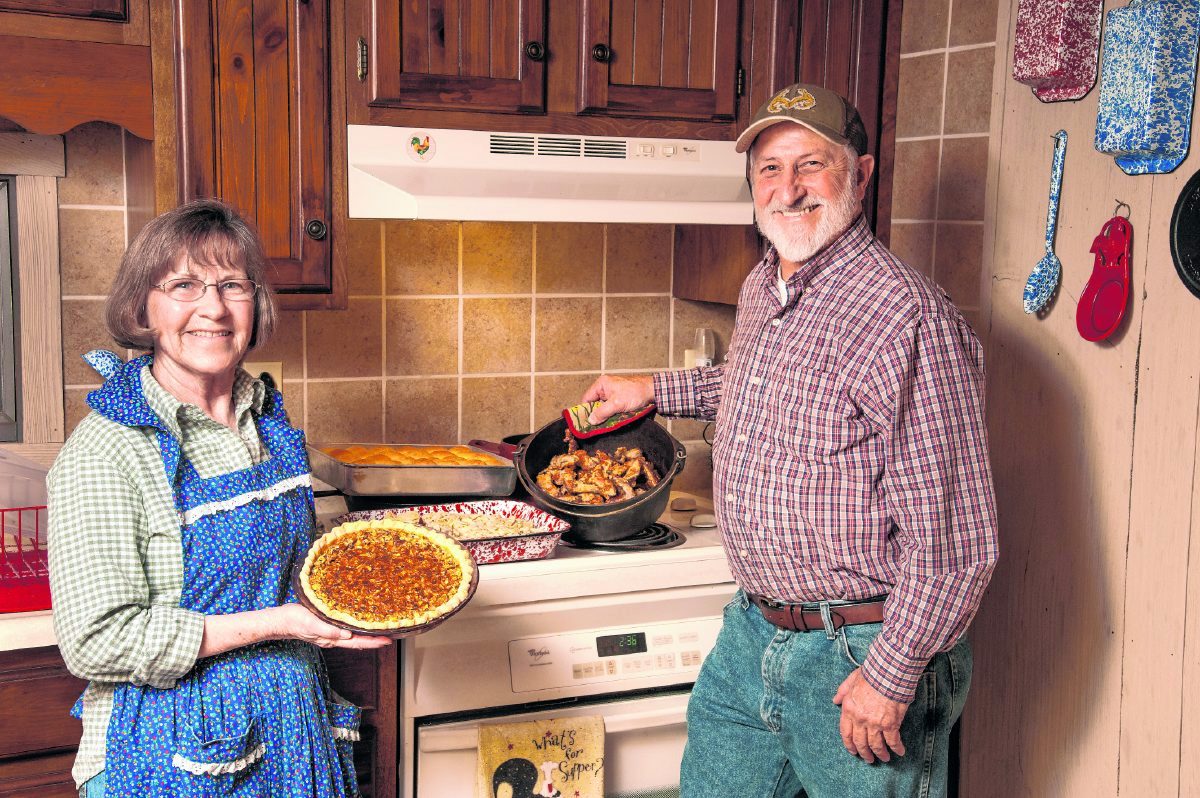
Meat, it’s what’s for dinner. But you might have to guess what kind.
Nobody does wild game dining with more flair and fun than Brad and Carol Herndon. They may not be judgmental about your standard fare hamburgers, hot dogs and other fast-food staples, but they think, cook and eat outside the box. Just not outside the woods.
So do their guests at the annual Pioneer Dinner hosted by the Brownstown couple since marrying in 1963 and Brad’s family members for a couple more generations.
Going on 64 years now, the Pioneer Dinner has normally been consummated, or consumed, by this date in the calendar year, but in 2021, it has been COVID-19 postponed until the world sees healthier days.
Generally, the outlook is eat first and ask questions later. Brad, whose mother, Doris, introduced the eat-like-they-used-to spirit of the frontier on Feb. 16, 1958, as a birthday celebration for him, “just like the pioneers would have eaten.” It was an educational meal.
Herndon, formerly a contributor to outdoor magazines, is now 78, and the Pioneer Dinner has evolved from try-it innovation to tradition to institution.
“It is a great tradition,” Herndon said. “I’ve been able to attend every one of them.”
Good thing since each one doubles as a birthday party for him.
“It kept growing,” he said.
Bigger menus. Bigger tables, covered with special table cloths, one passed through the family from Brad’s great-grandmother to his grandmother, Freida Leffler, described as somewhat of a genius at recognizing nutritional value in the woods.
For many years, Doris hosted the dinner at her house called “The Home Place” in Starve Hollow. From 1977 to 1997, the dinner shifted to Brownstown United Methodist Church. From 1998 on, the dinner table was set at St. Paul Lutheran Church in Wegan.
There may be 70 dishes at a meal, all made from ingredients found in the wild. Brad was raised in the outdoors from the time he could crawl, and “Nanny” Leffler preserved cabbage, turnips and carrots by burying them. She also was renowned for making apple pan dowdy.
Eating wild has gained the reputation of being good for you, or as Bowhunting 360, the Archery Trade Association said in a 2020 article, “Wild game animals provide lean, organize, hormone-free meat. Hunters who source and process their meat know its origins and how it was handled before they cooked and ate it.”
For some time, Doris Herndon chronicled the Pioneer Dinner in an article submitted to the Brownstown Banner. Brad Herndon said the report was eagerly awaited, and even years later, he bumps into people asking about the fate of the Pioneer Dinner. It lives on.
The favorite dish of Brad and Carol is fried squirrel, biscuits and gravy. Year-round, too, not merely annually.
Deer, elk, antelope, sage grouse, wild rice, Muscatine jelly are all liable to show up on the table. Brad’s favorite fish to cook is bluegill.
For the 50th annual Pioneer Dinner in 2007, the Herndons sought to piece together a spread of foodstuffs from all 50 states. Friends took on assignments. There was red salmon from Alaska, deer jerky from Alabama, alligator meat from Florida, wild turkey from Iowa, goat’s cheese from Maryland, sardines from Massachusetts, wild huckleberry jam from Montana, deer summer sausage from Ohio, honey from Rhode Island, black walnuts from Tennessee and bison from Wyoming.
This was a meal with grand ambition, but in the end, one hunter-gatherer who committed let down the group by failing to produce items from Texas and Oklahoma, so only 48 states were represented.
Brad notes he is a gatherer-eater, not a cook. Carol manufactures many dishes each year.
“I do most of it (the cooking),” she said. “Others pitch in.”
The Herndons can’t quite steer clear of the joking comment, “Does it taste like chicken?” But their palate is more developed, and they almost view an observation like that with bewilderment, if not flat out bemusement.
“Not everything does,” Carol diplomatically says.
Coyote, prepared in strips in a stew with gravy and vegetables, does not taste like chicken.
The only meat not welcome is skunk.
“I don’t think we want to have skunk,” she said. “Sometimes, I ask people what it tastes like. And they might say, ‘It was good. You would think it was pork.'”
Dreaming up a new twist in recent years, Brad and Carol introduced an annual “mystery meat” to the dinner. Guests tasted blind and only afterwards are told what was so juicy. This began in 2012 with a tentative step — muskrat salsa.
This was followed by ever bolder dishes such as barbecue groundhog, raccoon, beaver stew, barbecue wild boar, wild peacock and noodles and rabbit taco. The coyote stew was one of the mystery meats.
Many people say, “I would never eat that,” Brad said.
Until they do. They find out what it is, register surprise and are ready for a second helping.
As Brad Herndon says, the woods are full of things you can eat.
